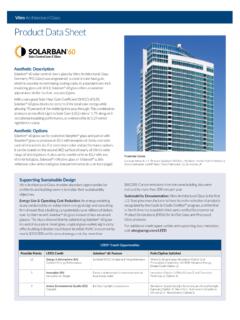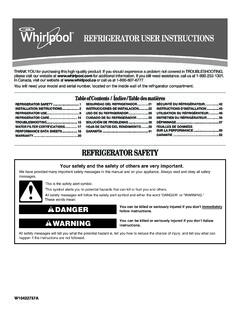Transcription of GLASS INSPECTION STANDARDS
1 GLASS INSPECTION STANDARDS . WA Wilson fabricates high quality tempered , insulated, and edged GLASS products. Any flaws that develop as a result of the manufacturing or handling process are inspected using the GLASS Industry STANDARDS ASTM C1036 for Flat GLASS , ASTM C1048 for Heat Treated GLASS , ASTM. C1376 for Low-E Coatings on Flat GLASS , ASTM C 1651 Roll Wave Optical Distortion for Heat Treated GLASS , and ASTM C 1503 for Mirrors. All of these documents are copyrighted and available for purchase at DIMENSIONAL TOLERANCES FOR RECTANGLES. THICKNESS RANGE LENGTH AND WIDTH. in INCHES TOLERANCE. GLASS THICKNESS (min-max) Cut Size Stock Sheet MM (SINGLE. STRENGTH) - .0101 1/16" 1/4". MM (DOUBLE. STRENGTH - 1/16" 1/4". MM (3/16" GLASS ) 1/16" 1/4". (1/4" GLASS ) - 1/16" 1/4". 10MM (3/8" GLASS ) - 3/32" 1/4". 12MM (1/2" GLASS ) - 1/8" 1/4". SURFACE IMPERFECTIONS. All inspections are done with the viewing angle at 90 degrees to the GLASS surface, uniform diffused lighting that stimulates daylight, and with the inspector looking thru rather than at the GLASS surface.)
2 Architectural GLASS that is produced as Annealed, tempered , non Low-E Insulated, or Laminated SCRATCHES AND RUBS. The inspector begins the INSPECTION by standing at a distance of 160 from the GLASS surface. The inspector then moves closer to the GLASS surface, stopping at the point where the scratch or rub is first detected. If this distance is between 160 and 132 then it cause for rejection. If the scratch or rub is visible when viewed between 132 and 40 and is over 3 long it is cause for rejection. If the scratch or rub is visible when viewed between 132 and 40 and it is less than 3 long, it is allowed as long as it is separated from a similar scratch or rub by at least 24 . If you need to be closer than 40 from the GLASS surface to view the scratch or rub, then it is allowed. BUBBLES, PITS, KNOTS, and DIRT. With the inspector standing at 39 from the GLASS surface, and the GLASS thickness is or less, bubbles, pits, knots, or dirt is allowed if the average of blemish's length and width is 1/16 or less.
3 Blemishes with an average length and width of 3/32 are allowed if they are separated from a similar blemish by at least 24 . Bubbles, pits, knots and dirt is not allowed if their average length and width exceeds 3/32 . EDGE CHIPS. DEPTH- measuring from the face of the GLASS a chip is allowed if it's depth does not exceed more than 50% of the GLASS thickness WIDTH- measuring the perpendicular distance from the edge of the GLASS to the inner edge of the chip, a chip is allowed up to half of the GLASS thickness or , whichever is greater; for mirrors up to half of the mirror thickness or 1/16 , whichever is greater. LENGTH- measuring parallel from the edge of the GLASS to the edge of a chip, a chip is allowed if its length does not exceed two times its width. Architectural GLASS Coated with Hard or Soft Coat Low-E. SCRATCHES AND RUBS. The inspector begins the INSPECTION by standing at a distance of 120 from the GLASS surface. The inspector then moves closer to the GLASS surface, stopping at the point where the scratch or rub is first detected.
4 If the scratch or rub is visible at a distance of 120 , is over 3 long, and is located in the central viewing area (defined as 80% of the length and 80% of the width dimensions centered on the lite of GLASS ) then it is cause for rejection. COATING PINHOLES. Coating pinholes greater than 1/16 of an inch are not allowed. Pinholes less than 1/16 in diameter are allowed if they are located outside of the central viewing area. At a distance of 120 . from the GLASS surface, three or more pinholes greater than 3/64 in size are not allowed if they are located within a 6 diameter cluster of one another. COLORATION. Low-e coated GLASS may exhibit a hue or coloration that is not apparent in architectural samples, especially in shaded or darkened light or when viewed at a glancing angle. This coloration is inherent to the coating process and is not a reason for rejection. Spandrel GLASS All inspections are done with the viewing angle at 90 degrees to the GLASS surface, standing outside the building, and at a distance of 180 from the GLASS surface.
5 Spandrel GLASS is not intended to be viewed from the interior. Color and reflectance may vary when viewed under a uniform, opaque background. This is not considered a defect. Heat Treated GLASS GLASS DISTORTION. The factors inherent in the heat treating process in a horizontal oven may change the surface of the treated GLASS and result in a distortion of reflected objects when viewed on the GLASS surface. The ability of the viewer to see this distortion is dependent on the size and shape of the GLASS , the location that the GLASS is glazed on the building, and the distance the viewer stands from the GLASS surface. Reflective coated GLASS as well as the expansion and contraction of the air space between the GLASS surfaces of an insulated unit can also enhance this distortion. These are not considered defects and are not cause for rejection. MAXIMUM BOW AND WARP TOLERANCES. Due to the nature of the furnace, GLASS that is heat treated is not as flat as annealed GLASS .
6 The amount of the distortion can be reduced by using heat strengthened in lieu of fully tempered GLASS . The following ASTM C1048 chart contains information on the allowable bow and warp based on the GLASS thickness, length, and width. GLASS THICKNESS. EDGE 1/8" 3/16" 1/4" 3/8" 1/2". DIMENSIONS. 0-20" 5/64" 1/8" 5/64" 5/64" 5/64". >20" - 35" 5/64" 5/32" 1/8" 5/64" 5/64". >35" - 47" 5/64" 13/64" 5/32" 5/64" 5/64". >47" - 59" 1/8" 9/32" 13/64" 13/64" 5/64". >59" - 71" 13/64" 11/32" 9/32" 13/64" 5/32". >71" - 83" 15/32" 15/32" 11/32" 15/64" 13/64". >83" - 94" 9/32" 17/32" 15/32" 9/32" 13/64". >94" - 106" 21/32" 17/32" 11/32" 9/32". >106" - 118" 3/4" 21/32" 15/32" 3/8". >118" - 130" 3/4" 9/16" 15/32". >130" - 144" 13/16" 21/32" 17/32". STRAIN PATTERN AND QUENCH MARKS. Heat treated GLASS may display visible strain patterns, also called quench marks. These appear as geometric iridescence colored shadows. The strain pattern may appear under certain lighting conditions, such as polarized light.
7 Strain patterns are the result of stress created in certain areas of the GLASS during the air quench cooling process. Strain pattern is an inherent characteristic of heat treated GLASS and is not considered a defect. Cut Sized Mirrors SCRATCHES AND RUBS. The inspector begins the INSPECTION by standing at a distance of 60 from the mirror surface. The inspector then moves closer to the GLASS surface, stopping at the point where the scratch or rub is first detected. If this distance is between 60 and 24 then it cause for rejection. If the scratch or rub is visible when viewed between 24 and 8 and it is less than 3 long, it is allowed as long as it is separated from a similar scratch or rub by at least 24 . If you need to be closer than 8 from the mirror surface to view the scratch or rub, then it is allowed.



